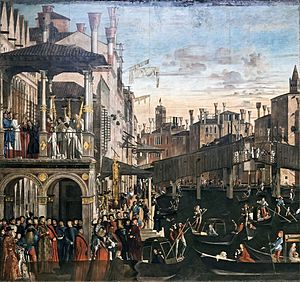Rialto Market, Icon of Venice, about to Close
- Stefania Gioia
- Aug 29, 2018
- 3 min read
Depopulation, "hit and run" tourism and sky-high bills are killing Rialto market. Today less than ten stalls are struggling to survive, not supported by institutions.

Established almost a thousand of years ago, Rialto market is one of the most ancient in Italy, as well as the settlement of the very first commercial exchanges in Venice. Named Rivoaltum because of its deep seabed, at that time the area was the ideal docking point for large ships loaded with any kind of goods.

Very well stocked and much larger in the past, besides the Pescarìa (seafood market) and the Erbarìa (produce market) you can visit nowadays, the trade area included the Naranzarìa (citrus market) and the Beccarìa (meat market). Milk and cheeses were sold at the near Casarìa, while spices, gold and other metals were to be found at Ruga degli Spezieri and Ruga degli Oresi. The Spadarìa and the Frezzarìa used to be weapons’ factory. Located very close to the market, Banco del Giro, a real bank founded by the Venetian Republic, ensured the circulation of currency. Today it gives the name to the popular wine bar Bancogiro.
If most of the stalls had already disappeared with the years and the obvious economic transformation, the prestigious fish market, in good health till the beginning of 2000’s, recently suffered a dramatic change. Under the colonnade, instead of dozens of vendors selling canoce (mantis shrimps), moeche (soft shelled crabs), shrimps, clams and other fresh seafood, today less than 10 stalls struggle to survive.
Venice’s depopulation turned it in a ghost city and the actual residents, whose favorite shopping district used to be Rialto market, are now perhaps about 30.000. Tourists, on the other side, are generally visiting the area just to take pictures: staying at hotels and b&bs, often for a short vacation, they’re not interested in buying food. Many visitors, in order to save money, eat at the fast food chains, missing the opportunity to taste the local seafood at the excellent restaurants that still source from the fishmongers.
Marco Bergamasco has been one of them for almost 30 years: originally a draftsman, he chose to be a fisherman exclusively for passion. Many of the best restaurants, such as the Alajmo’s Caffe’ Quadri, Riviera, Il Covo or Anice stellato, just to name a few, still purchase his fresh seafood.

While a 12 hour work day never scared him, as many other colleagues he recently decided to definitively close his stall: “The residents’ “diaspora” is not the only problem, he says - the stall itself and the rent of the space - about 3,000 euros a month - are very expensive; water and electricity bills are sky-high, since we pay as we were simple domestic users; not long ago we were forbidden to sell certain types of shellfish... Institutions literally abandoned us”. A trend that is now difficult to reverse, also considering that fewer and fewer young people slightly take interest in this profession.

“While a stall in the 90’s was worth about 100,000 euros, he continues - the price offered today is barely 12,000 euros”. Rialto market, once regarded as important as Eveleigh market in Sidney, Mercato de Ribeira in Lisbon, New Delhi in India and Valladolid in Mexico, is now about to close. It is just a matter of time.
Marco’s words, though sad, are extremely rational. Looking through the window he can’t recognize his city anymore. Just when he wakes up very early in the morning, and the pristine light of the sunrise licks desert alleys and empty canals, right then, he has the privilege to admire his beautiful city. He knows he won’t be here for long. He’s planning to move where it’s still possible to live doing the job he loves.
Times are quickly changing, and we can’t help but adjust and develop according to the new rules. However, in a city like Venice, shouldn’t certain professions be protected? Shouldn’t some historical areas be preserved? Shouldn’t the flocks of tourists be regulated and educated, in order to save what’s left of this magnificent maritime republic?
Once and for all, the institutions should operate in order to repopulate the city, protect the local culture, revitalize the traditional jobs, safeguard fishmongers, shop owners, artisans, local entrepreneurs.
In our own small way, we aim to raise awareness among our clients, friends and followers, but we know this won’t help without the government’s effective support. Is it too late for hope?

#rialtomarket #fish #seafood #savevenice #veniceicon #venicesymbol #depopulation #ilovemycity #ilovevenice #fishmongers #fishermen #stalls #restaurants #haveaglassinvenice #respectvenice #offthebeatenpath #explore #travel #venicetour
Photo credits: Afar, Venice Tours, When in Venice.

















Comments